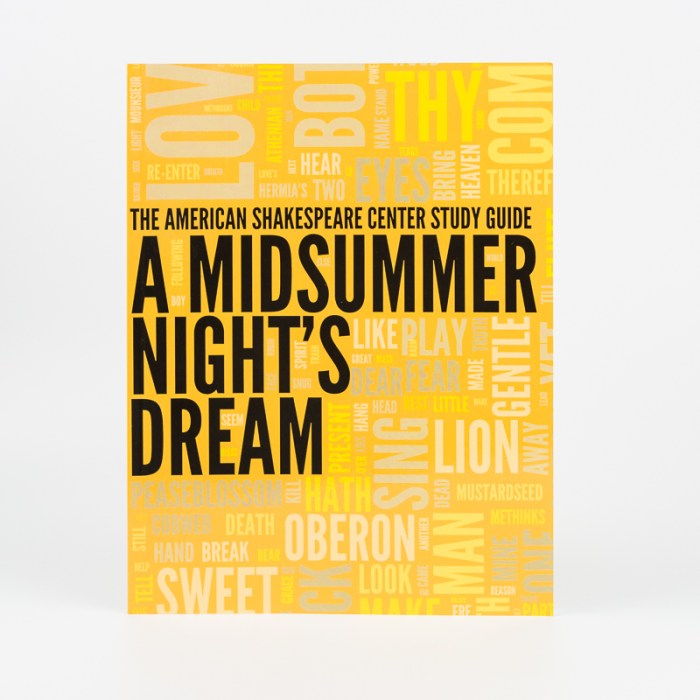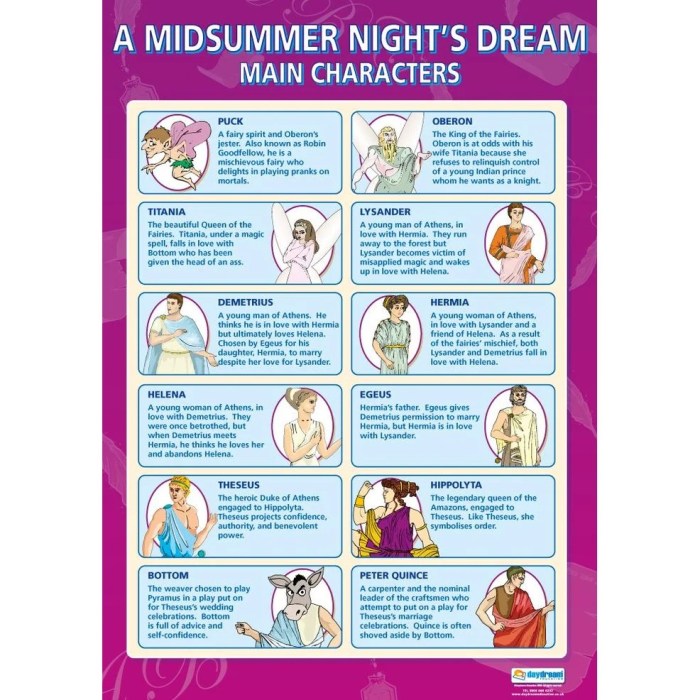Embark on a literary journey with our comprehensive Midsummer Night’s Dream study guide, a captivating exploration of Shakespeare’s enchanting forest and its timeless themes of love, magic, and illusion.
This guide delves into the play’s rich tapestry, providing insightful analysis of its characters, themes, and cultural significance.
Play Overview: Midsummer Night’s Dream Study Guide

A Midsummer Night’s Dream is a comedy written by William Shakespeare. The play is set in a forest near Athens and follows the adventures of four young lovers, a group of fairies, and a group of rude mechanicals.
The main themes of the play include love, marriage, and the nature of reality. The play also explores the conflict between the natural world and the civilized world.
Main Characters
- Hermia: A young woman who is in love with Lysander.
- Lysander: A young man who is in love with Hermia.
- Helena: A young woman who is in love with Demetrius.
- Demetrius: A young man who is in love with Hermia.
- Oberon: The king of the fairies.
- Titania: The queen of the fairies.
- Puck: A mischievous fairy.
- Bottom: A weaver who is transformed into a donkey by Puck.
Context and Background

William Shakespeare’s A Midsummer Night’s Dreamis a product of its time and place, reflecting the cultural and historical influences of Elizabethan England. The play’s setting in an enchanted forest and its themes of love, magic, and transformation are deeply rooted in the folklore, mythology, and social customs of the period.
Historical and Cultural Context
The play was written during a period of great social and cultural change in England. The Protestant Reformation had challenged the authority of the Catholic Church, and new ideas about science and humanism were emerging. These changes were reflected in the play’s exploration of the conflict between reason and emotion, and its questioning of traditional gender roles.
Significance of the Setting and Time Period
The play’s setting in an enchanted forest creates a sense of wonder and magic. The forest is a place where anything can happen, and where the boundaries between reality and imagination blur. The play’s time period, the midsummer night, is also significant.
Midsummer was a time of celebration and revelry, and it was believed that on this night, the fairies were particularly active.
Literary Influences and Sources
Shakespeare’s play draws on a variety of literary sources, including Ovid’s Metamorphoses, Chaucer’s The Canterbury Tales, and the works of classical Greek and Roman playwrights. These sources provided Shakespeare with inspiration for his characters, plot, and themes.
Character Analysis
The characters in A Midsummer Night’s Dreamare driven by a variety of motivations, including love, jealousy, and a desire for power. These motivations often lead to conflict between the characters, which is ultimately resolved through the intervention of the fairies.
The relationships between the characters are complex and ever-changing. At the beginning of the play, Hermia is in love with Lysander, but her father has promised her to Demetrius. Demetrius is in love with Helena, but she is in love with Lysander.
This love triangle leads to a great deal of confusion and heartache.
The use of symbolism and allegory in the characterization is also significant. For example, the four lovers can be seen as representing the four elements: Hermia is associated with earth, Lysander with air, Demetrius with fire, and Helena with water.
This symbolism adds depth and richness to the characters and their relationships.
Character Motivations
- Hermia: To marry Lysander and escape the arranged marriage with Demetrius.
- Lysander: To marry Hermia and defy the authority of Hermia’s father.
- Demetrius: To marry Hermia and gain her father’s approval.
- Helena: To win the love of Demetrius.
Character Relationships, Midsummer night’s dream study guide
The relationships between the characters are complex and ever-changing. At the beginning of the play, Hermia and Lysander are in love, but Demetrius is in love with Helena. This love triangle leads to a great deal of confusion and heartache.
The intervention of the fairies ultimately resolves the conflict between the characters. Oberon and Titania use their magic to bring about a happy ending for all of the lovers.
Symbolism and Allegory
The use of symbolism and allegory in the characterization is also significant. For example, the four lovers can be seen as representing the four elements: Hermia is associated with earth, Lysander with air, Demetrius with fire, and Helena with water.
This symbolism adds depth and richness to the characters and their relationships. It also allows Shakespeare to explore the themes of love, jealousy, and power in a more complex and nuanced way.
Themes and Motifs
A Midsummer Night’s Dream is rich in themes and motifs that explore the complexities of human nature and the interplay between reality and illusion. These elements contribute significantly to the play’s meaning and enduring appeal.
Theme: Love
Love is a central theme in the play, depicted in its various forms, from the passionate and irrational to the unrequited and playful. The chaotic relationships among the four young lovers—Hermia, Lysander, Demetrius, and Helena—highlight the irrational and unpredictable nature of love, while the mature and harmonious love between Theseus and Hippolyta represents a more stable and enduring form of affection.
Theme: Magic
Magic plays a transformative role in the play, creating a realm of possibilities and illusions. The presence of fairies and their magical powers disrupts the boundaries of reality, allowing characters to experience extraordinary events and encounter their inner desires. The love potion, in particular, serves as a catalyst for the play’s chaotic events, revealing the transformative power of magic and the potential for both chaos and resolution.
Theme: Illusion
Illusion is closely intertwined with magic in the play, blurring the lines between reality and perception. The dream-like atmosphere of the forest creates a sense of unreality, where characters are often deceived by appearances and mistaken identities. This theme explores the subjective nature of experience and the difficulty of distinguishing between what is real and what is imagined.
Motif: The Forest
The forest in A Midsummer Night’s Dream is a significant motif, representing a realm of transformation and enchantment. It is a place where the boundaries of reality dissolve and the characters’ inner desires and fears are revealed. The forest serves as a catalyst for the play’s conflicts and resolutions, providing a space for both chaos and renewal.
Motif: Dreams
Dreams play a crucial role in the play, both literally and figuratively. The characters’ experiences in the forest are often dream-like, blurring the boundaries between reality and imagination. The play itself is framed as a dream, suggesting that the events depicted may not be entirely real but rather a reflection of the characters’ subconscious desires and fears.
Motif: Transformation
Transformation is a recurring motif in the play, both physical and psychological. The love potion transforms the characters’ desires, leading to unexpected and often comical situations. The characters also undergo emotional and psychological transformations throughout the play, as they confront their own identities and relationships.
Dramatic Structure and Language

The play’s structure follows a traditional five-act structure, with each act divided into several scenes. This structure allows Shakespeare to develop the play’s plot and characters in a clear and organized way.
The play’s language is rich and poetic, filled with imagery and metaphor. Shakespeare uses language to create a sense of wonder and magic, and to explore the play’s themes of love, marriage, and the nature of reality.
Use of Scenes, Acts, and Subplots
The play’s five acts are divided into 20 scenes, which allows Shakespeare to shift between different locations and characters quickly and efficiently. This structure helps to create a sense of urgency and excitement, and it keeps the audience engaged in the play’s action.
The play also contains several subplots, which run parallel to the main plot. These subplots help to develop the play’s characters and themes, and they provide comic relief from the play’s more serious moments.
Use of Language, Imagery, and Metaphor
Shakespeare’s use of language in A Midsummer Night’s Dreamis highly sophisticated and poetic. He uses a wide range of literary devices, including imagery, metaphor, and simile, to create a sense of wonder and magic.
For example, in the famous “Puck’s Song” from Act II, Scene ii, Shakespeare uses imagery to create a vivid picture of the forest at night:
Through the forest have I gone,
Both by land and sea;
And I have seen such sights,
As you shall see no more.
Shakespeare also uses metaphor to explore the play’s themes. For example, in the play’s opening scene, Theseus compares love to a “madman” and a “lunatic.” This metaphor suggests that love is a powerful and irrational force that can drive people to do strange and unpredictable things.
Cultural Impact and Adaptations
A Midsummer Night’s Dreamhas had a profound cultural impact since its inception. Its enduring popularity has led to numerous adaptations across various artistic mediums, each contributing to the play’s legacy and interpretation.
The play’s whimsical and fantastical elements have captivated audiences for centuries. Its exploration of love, identity, and the nature of dreams has resonated with people from all walks of life. A Midsummer Night’s Dreamhas been translated into countless languages and performed in theaters around the world, becoming a staple of the dramatic repertoire.
Adaptations
The play’s enduring appeal has inspired numerous adaptations in various forms, including:
- Film:Notable film adaptations include Max Reinhardt’s 1935 version starring James Cagney and Olivia de Havilland, and Michael Hoffman’s 1999 adaptation starring Kevin Kline and Michelle Pfeiffer. These films have brought the play’s magic to the silver screen, reaching a wider audience and introducing new generations to its timeless themes.
- Theater:Countless theater companies have staged their own interpretations of A Midsummer Night’s Dream, each bringing unique perspectives and artistic visions to the production. These productions have showcased the play’s versatility and adaptability, allowing directors and actors to explore different interpretations and stagecraft techniques.
- Opera:Benjamin Britten’s 1960 opera adaptation, A Midsummer Night’s Dream, is a renowned work in the operatic repertoire. Britten’s music captures the play’s ethereal and enchanting atmosphere, while his libretto remains faithful to Shakespeare’s original text. The opera has been performed by opera companies worldwide, further extending the play’s reach and introducing it to new audiences.
These adaptations have not only popularized A Midsummer Night’s Dreambut have also influenced its interpretation and understanding. Each adaptation brings its own unique perspective and artistic vision, contributing to the play’s ever-evolving legacy and ensuring its continued relevance for future generations.
FAQ Section
What is the main conflict in A Midsummer Night’s Dream?
The play revolves around the conflict between love and reason, as the characters navigate the complexities of romantic relationships and the irrationality of love.
Who are the main characters in the play?
The play features a large cast of characters, including the four Athenian lovers (Hermia, Lysander, Demetrius, and Helena), the mischievous fairies (Oberon, Titania, and Puck), and the rude mechanicals (Bottom, Quince, and Flute).
What is the significance of the forest setting in the play?
The forest serves as a magical and transformative space, where the characters’ inhibitions are released and the boundaries of reality are blurred.